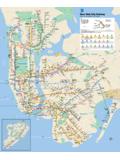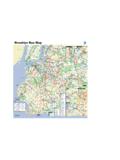Transcription of The 200 Foot Rule - Welcome to NYC.gov | City of New York
1 Measuring the Distance The 200 and 500 foot rules The 200 foot Rule The Alcoholic Beverage Control Law prohibits certain licenses from being issued if the location of the establishment is on the same street and within 200 feet of a building that is used exclusively as a school, church, synagogue or other place of worship. This restriction is commonly called the 200 foot rule and applies to any retail establishment where liquor will be sold for on premises consumption and any retail establishment where liquor or wine will be sold for consumption off the premises. Measurement of distance The law provides that the measurement be taken in a straight line from the center of the nearest entrance of the school/place of worship to the center of the nearest entrance of the establishment. The distance is determined using only entrances that are regularly used to give ingress to (a) the students of the school, (b) the general public into the place of worship; and (c) patrons into the establishment.
2 Emergency/fire exits, maintenance access, and doors to gain access to non-public areas are not used in the measurement. If the entrance is set back from the sidewalk by a walkway or doorway, the measurement is taken from the center of the line where the walkway/doorway meets the sidewalk. For an establishment in a multi-story building, the building entrance at street level is used. Corner locations The statute refers to the school/place of worship being on the same street as the licensed premises. The buildings do not have to be on the same block. With respect to an establishment or school/. place of worship on a corner lot, the building is considered to be on both streets, whether or not there is an entrance to the building on both streets. Exceptions to the rule Grandfather clause If the 200 foot rule applies to a particular location, the Authority does not have the discretion to grant the application.
3 Even if the school/place of worship consents to the issuance of the license, the Authority cannot approve the application. If the Authority discovers that an establishment has been licensed in violation of the rule, it cannot allow the violation to continue when the license comes up for renewal. The statute does, however, provide for certain exceptions to the rule: establishments in operation since December 5, 1933 (the end of prohibition);. if the location was licensed before the school/place of worship existed, the Authority can renew the license and approve applications to transfer ownership;. if a hotel has an existing RL [restaurant liquor] license, it may obtain a HL [hotel liquor] license;. applications for a CL [club liquor] license when the club is affiliated with the school/place of worship.
4 A legitimate theater operated by a not-for-profit organization;. and the Authority may permit the licensee to move a licensed premises that has an exception to another location within 200 feet of the school/church, as long as the new location is not closer than the old location. Exclusive use as school/place of worship While the law uses the phrase building used exclusively as a school/. place of worship, the courts have adopted a test that looks to whether the building is used primarily as a school/place of worship. The building will still be considered a school/place of worship as long as any use is incidental to, and are not inconsistent with or detracting from the predominant character of the building as a school/place of worship. In 2007, the 200 foot rule was amended to clarify that the use of a building Eliot Spitzer for certain purposes would be considered incidental to its primary use as Governor a place of worship.
5 Those uses include, but are not limited to: Daniel the conduct of legally authorized games of bingo or other games of chance held as a means of raising funds for the not-for-profit Chairman religious organization which conducts services at the place of Noreen Healey worship or for other not-for-profit organizations or groups;. use of the building for fund-raising performances by or benefitting Commissioner the not-for-profit religious organization which conducts services Joshua at the place of worship or other not-for-profit organizations or CEO groups;. the use of the building by other religious organizations or groups for religious services or other purposes;. the conduct of social activities by or for the benefit of the congregants;. the use of the building for meetings held by organizations or groups providing bereavement counseling to persons having suffered the loss of a loved one, or providing advice or support for conditions or diseases including, but not limited to, alcoholism, drug addiction, cancer, cerebral palsy, Parkinson's disease, or Alzheimer's disease; and the use of the building for blood drives, health screenings, health information meetings, yoga classes, exercise classes or other activities intended to promote the health of the congregants or other persons.
6 And use of the building by non-congregant members of the community for private social functions. In addition, the amendment also provided that a building would still be considered as used exclusively as a place of worship even when the not-for-profit religious organization occupying the place of worship accepts payments from those using the building to assist in defraying costs related to that party's use of the building. The 500 foot Rule Ordinarily, an application for an on-premises liquor license must be approved unless the Authority finds there is good cause not to issue the license. The Alcoholic Beverage Control Law, however, contains restrictions on the approval of certain on- premises liquor licenses if the location is within a 500 foot radius of certain other establishments with on-premises liquor licenses.
7 The restrictions apply only in cities, towns or villages with a population of 20,000 or more. The restrictions are commonly referred to as the 500 foot rule.. Establishments subject to the 500 foot rule Applications for licenses under Section 64, 64-a, 64-c and 64-d of the Alcoholic Beverage Control Law are all, to some degree, subject to the 500 foot rule. These statutes provide for full (liquor, wine and beer) liquor licenses for the on-premises license. A license under Section 64 can only be issued to a restaurant, hotel with a restaurant, catering establishment, club, vessel or aircraft. Establishments obtaining a license under this section must have a kitchen, with a chef, serving meals. Section 64-a provides for the special on-premises license. The statute allows certain establishments to obtain an on-premises license without meeting the restaurant/kitchen requirement of Section 64.
8 These establishments fall into two categories: 1) nightclubs, bars, taverns, etc, that do not have kitchen facilities and primarily serve alcoholic beverages rather than food; and 2) theaters and other entertainment facilities. Establishments obtaining a license under Section 64-a are not required to have kitchen facilities, but must regularly keep food (sandwiches, soups, etc.) available for sale to customers. Section 64-c provides for the restaurant-brewer license. In addition to allowing the licensee to brew a limited amount of beer on the premises, the licensee must operate a restaurant at the establishment. Pursuant to Section 64-d a cabaret license is required for any on-premises establishment that: (1) permits musical entertainment, singing, dancing or other forms of entertainment; and (2) has a capacity of 600 or more persons.
9 This section primarily addresses large nightclubs. It should not be confused with the cabaret permit issued by the City of New York, which is required for certain establishments regardless of whether alcoholic beverages are served. Exceptions to the rule Grandfather Public Interest clause If the location is subject to the 500 foot rule, and no other exception applies, the license cannot be issued unless the State Liquor Authority makes an affirmative The 500 foot rule finding that it is in the public interest to issue the license. This clearly creates a specifically excludes any presumption that the license should not be issued. There is, however, no public licensed establishment interest exception for applications for a cabaret license. that was licensed when the rule went into effect The 500 foot rule requires that the Authority consult with the municipality or on November 1, 1993.
10 If community board and conduct a hearing to gather facts to determine whether the an application is received public interest would be served by issuing the license. This is commonly referred for an establishment at a to as the 500 foot hearing. When considering whether it would be in the public location that has been interest to approve the application, the Authority may consider the following: continuously licensed since that date, it is the number, classes and character of other licensed premises not only not subject to the rule. in the area where the proposed establishment will be located but also Continuously means in the particular municipality (or subdivision of the municipality);. without interruption. whether the applicant has obtained all other necessary governmental If the location was not licenses and permits.

















